26 Types of Flowering Succulents (With Pictures)
-
- Last updated:
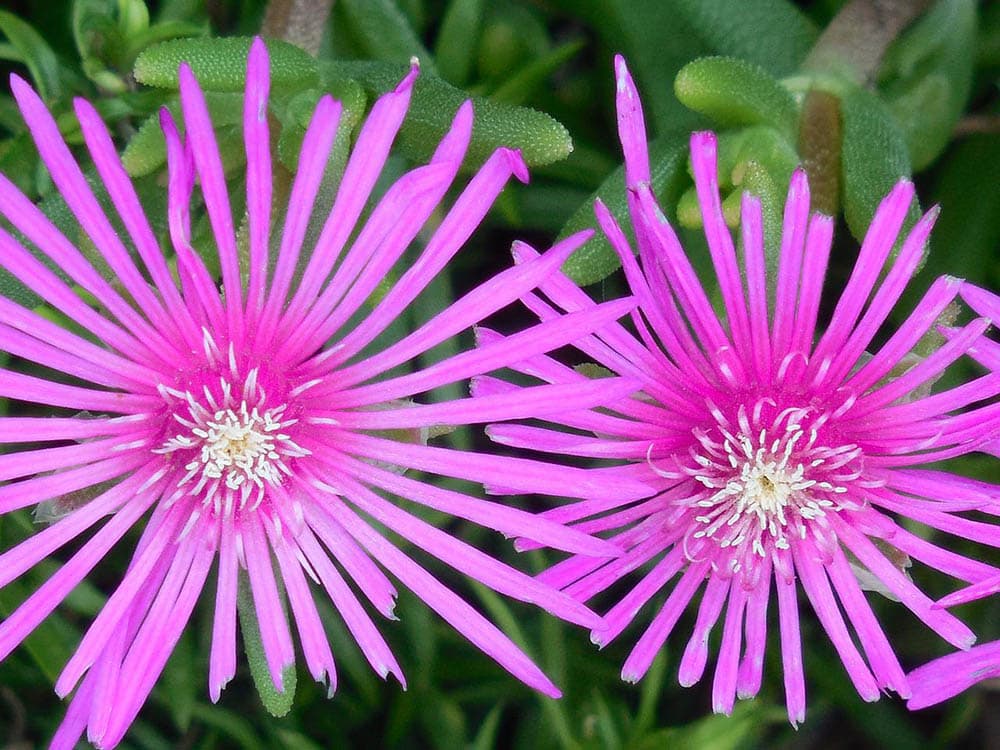
If you’re relegating your succulents to the living room bookshelf, you may not realize their hidden potential. When you give them sun and fresh air, many succulents offer incredible blooms to add intense layers of color atop the already gorgeous foliage. There may even be a succulent in your room that you had no idea could offer mesmerizing flowers.
If your climate can provide, succulents deserve their time in the sun, and you’ll be glad you made the addition to the landscaping. Yet with all the available varieties, some will be more practical for your flower garden. Though many succulents bloom year after year, monocarpic varieties only flower once before dying, and some don’t flower at all!
To make sure you get the most eye-catching and jaw-dropping displays in your garden, try any of these 26 types of flowering succulents.

The 26 Types of Flowering Succulents
1. Graptopetalum Superbum

| USDA Hardiness Zone: | 9–11 |
| Flowers: | Yellow |
| Size: | 5” wide, 5” high |
Graptopetalum superbum, or “Beautiful Graptopetalum”, produces clumping florets with farina-coated, tongue-shaped leaves in gray, lavender, and pinkish colors. Five-inch wide rosettes grow at the end of stems that continue growing up until the weight of the rosette pulls it into a pendant. The arching stems cause them to spread up to 3 feet.
Like other succulents, Graptopetalum superbum thrives in sandy, well-drained soil. Give them lots of sun and a touch of fertilizer, and you’ll see yellow flowers with red accents in early spring.
2. Graptoveria Fred Ives

| USDA Hardiness Zone: | 9–11 |
| Flowers: | Yellow |
| Size: | 12” wide, 24” high |
Flower or no flower, the variegated rainbow of colors on robust leaves of Graptoveria Fred Ives is more than enough to make a statement in a room or as a ground cover. Colors vary according to temperature and sunlight exposure on the foot-wide rosettes. In the summer, it produces inflorescences of yellow and red flowers.
3. Jade Plant
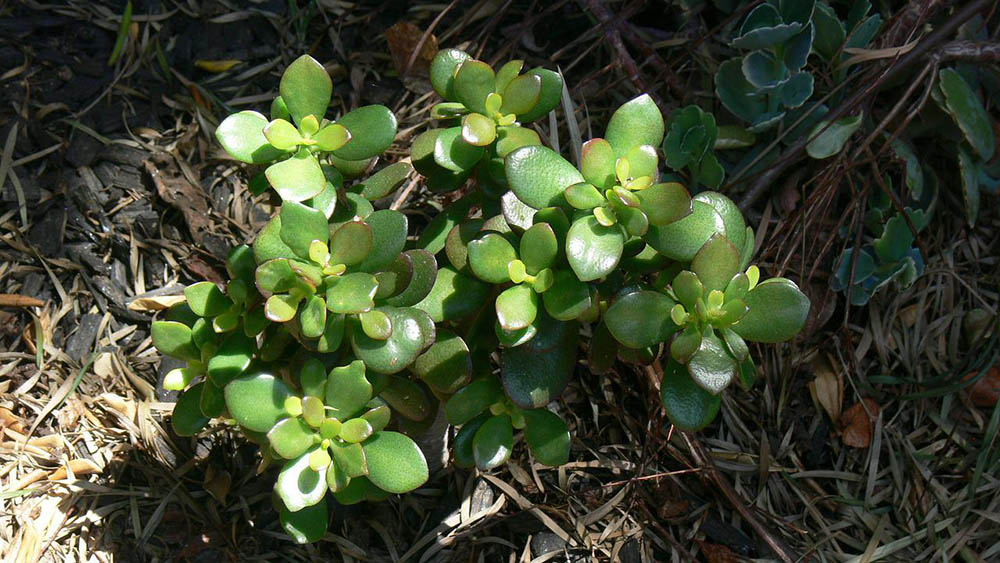
| USDA Hardiness Zone: | 9–12 |
| Flowers: | White |
| Size: | Up to 5’ wide, 9’ tall |
There are several types of Crassula Ovata, or “jade plant”, but the most common is an evergreen shrub that produces shiny green leaves with a contrasting deep red edge. They can grow indoors in a pot, or you can let them grow into a large shrub outdoors. Let it thrive in sunlight, and you’ll get the best coloration in the leaves and sparkling white flower highlights from fall to spring.
4. Desert Rose
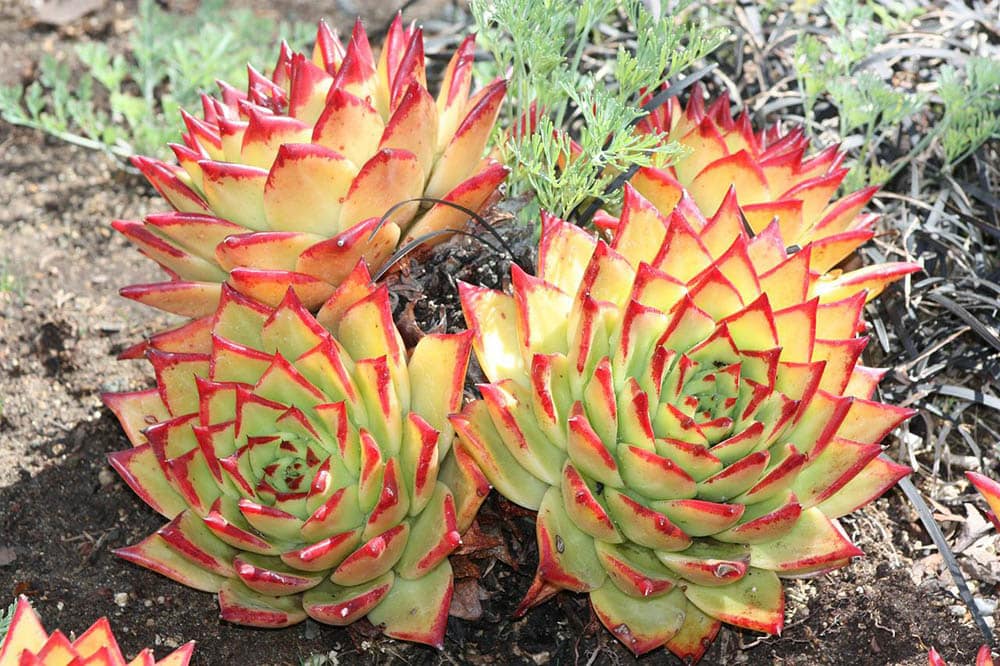
| USDA Hardiness Zone: | 10–12 |
| Flowers: | White, red, pink |
| Size: | Up to 3’ wide, 10’ tall |
The Desert Rose (Adenium Obesum) has a distinct look in its thick, elephant-like trunk and long stems with spirals of thin green leaves. The succulent shrub is a slow grower and can only stay outside if there’s no chance of frost (zone 10 or above). But even if you do have to bring it inside, give it enough sunlight, and you can still achieve the grand white and pink flowers that make it so popular.
5. Rock Purslane
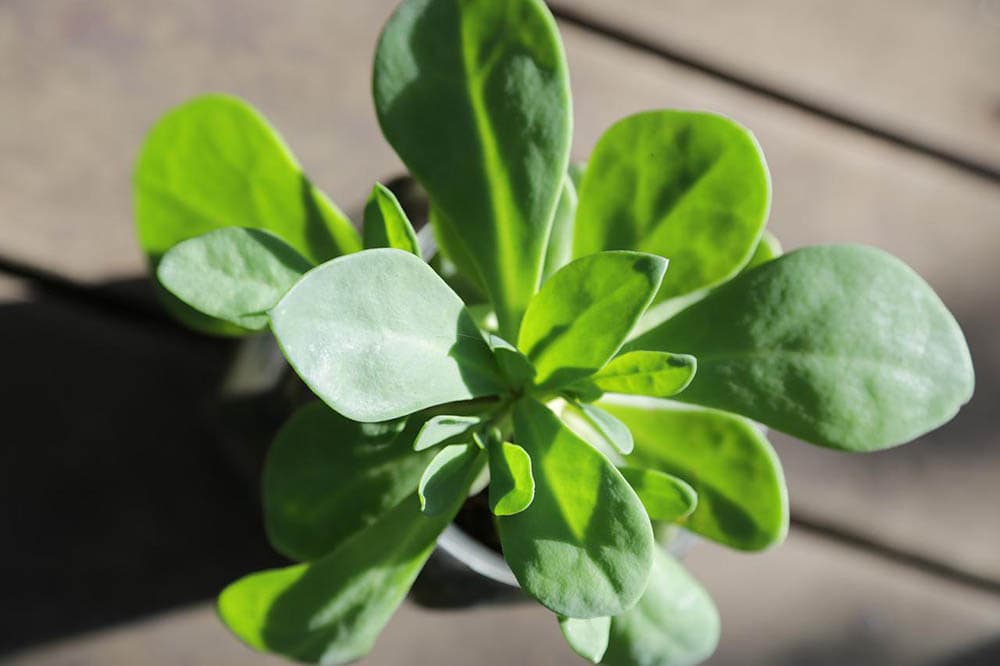
| USDA Hardiness Zone: | 9–11 |
| Flowers: | Magenta, purple, red, or white |
| Size: | 24” wide, 18” tall |
Calandrinia plants, also called Rock Purslane, are succulent shrubs that develop tight bushes of blue-green leaves. From spring to fall, thin stems erupt from the shrub, each producing a single purple flower at the end that dances several inches above the plant. Blooms only emerge for a day before dying back, but with the sheer number of stems each plant produces, it will continue flowering for months.
6. October Daphne
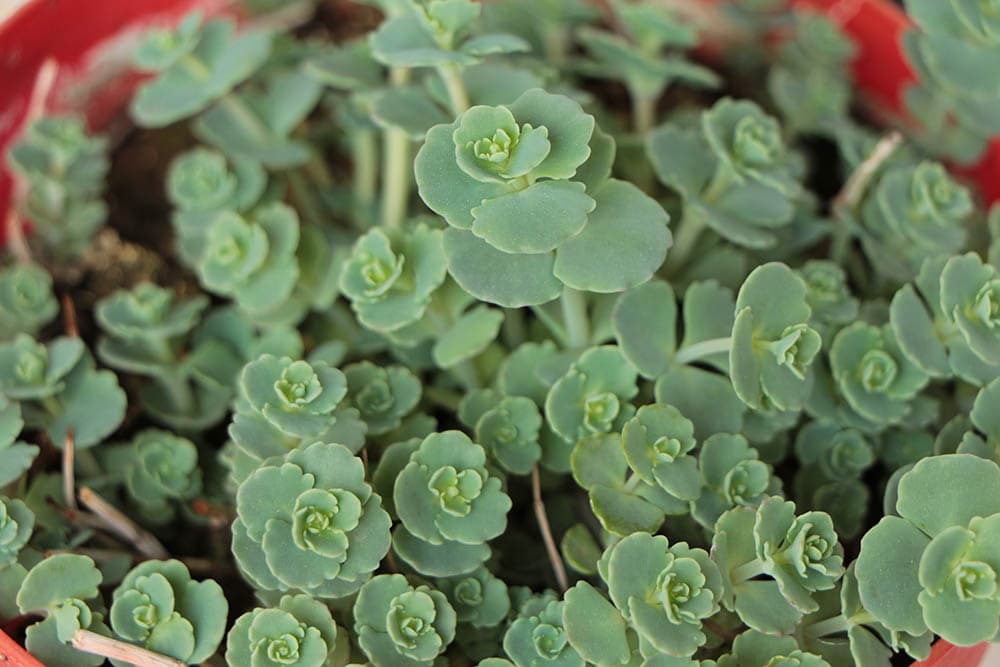
| USDA Hardiness Zone: | 3–9 |
| Flowers: | Pink |
| Size: | 24” spread, 8” tall |
Sedum sieboldii, aka Hylotelephium sieboldii or October Daphne, is a low-growing plant consisting of long, arching stems that grow up to 12” long. The blue leaves that run along each stem in whorls of three feature attractive purple edges, and different types of October Daphne sport spectacular variegation incorporating creamy yellow shades. In the fall, it grows plump fuzzball clusters of tiny pink flowers.
October Daphne is more cold-tolerant than most succulents. The deciduous plant can survive in temperatures as low as -10°F by going dormant, making it easy to get the best growth and brightest blooms outside each year.
7. Marble Buttons
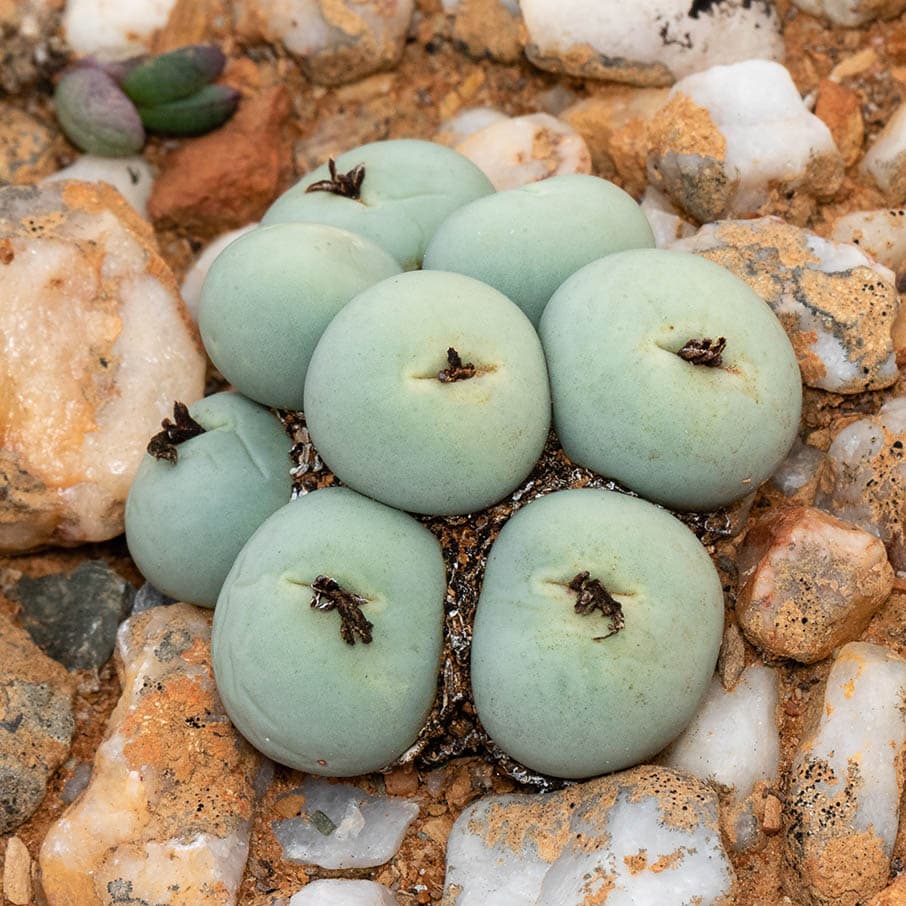
| USDA Hardiness Zone: | 10–11 |
| Flowers: | Yellow |
| Size: | 5” diameter |
Marble buttons (Conophytum calculus) are quirky in every way. They form in green stemless bulbs roughly 1–2” in diameter and multiply over time to create a clump of buttons. New leaves emerge from within the plant as the old leaf dies after a year.
Nocturnal flowers pop up in the fall. A single stem grows from a slit at the top of each button, showing off a gorgeous blossom of thin yellow petals when the sun goes down.
8. Woolly Rose

| USDA Hardiness Zone: | 9–11 |
| Flowers: | Yellow and orange |
| Size: | 8” wide, 5” high |
The appropriately named Woolly Rose, or Echeveria “Doris Taylor”, consists of a bright green open rosette. Each of its fleshy leaves has a coat of snowy white cilia. When given enough bright sunlight, the leaves develop a contrasting red tip.
Woolly rose is easy to propagate, and it produces numerous offshoots. From spring through fall, arching fuzz-covered stems emerge and develop exciting blossoms in hot pinks, oranges, and yellows.
9. Crown of Thorns

| USDA Hardiness Zone: | 9–12 |
| Flowers: | Yellow |
| Size: | 3’ wide, 6’ high |
A succulent from Madagascar, Euphorbia Milii, or “Crown of Thorns”, is as unique as the island nation from which it hails. Its long, thorn-covered branches are imposing, but that’s the only drawback to these showy shrubs. Nondescript yellow flowers sit within vivid red or yellow bracts resembling petals.
The plant produces flowers for long stretches. While the flowering flourishes in spring and summer, it remains from late winter until fall. It’s an easy plant to keep because it is resistant to most pests and isn’t picky about when it flowers. Although it isn’t frost-hardy, you can keep it indoors and still be able to treat yourself to its bright red display.
10. Flaming Katy

| USDA Hardiness Zone: | 10-12 |
| Flowers: | Red, orange, pink, yellow, or white |
| Size: | 24” wide, 24” high |
Kalanchoe plants are one-of-a-kind in shape and color, growing big, bold leaves showing unique patterns in assorted shades. The Flaming Katy (Kalanchoe blossfeldiana) is no different, with its green paddle-shaped leaves glowing tinges of red on their perimeter.
Flowers arrive in a single color. But depending on the variety, the plant will bloom bouquets in red, orange, pink, or yellow. It makes an excellent house plant and can tolerate some shade, but only plant it outside if there’s no risk of frost.
11. String of Pearls
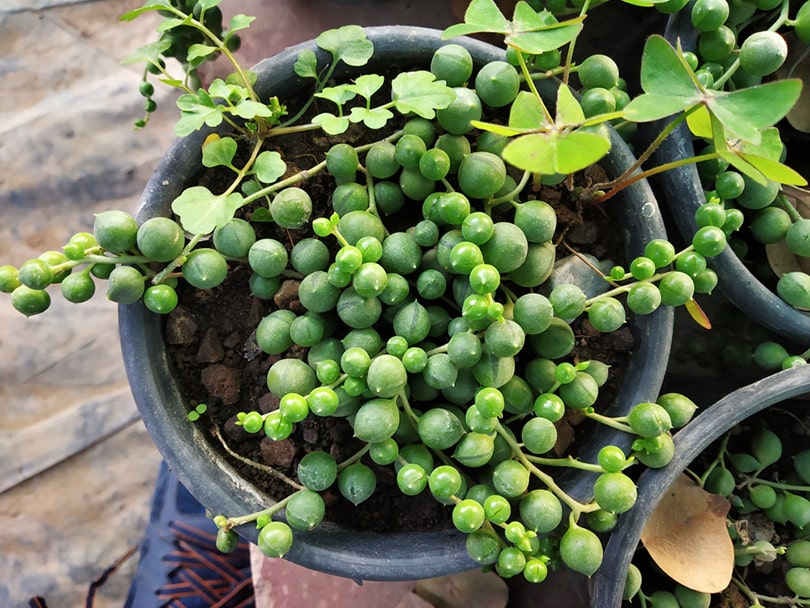
| USDA Hardiness Zone: | 9–12 |
| Flowers: | White |
| Size: | Up to 3’ wide, 3’ long |
Senecio rowleyanus, or “string of pearls”, is an intriguing succulent and delightful enough without any flowers. Long green vines cascade out, with each lined end to end with rows of green beads. They can make a dense ground cover, and they’re gorgeous in a hanging pot or on a shelf indoors. Given a chance to flower in summer, they’ll bloom subtle white blossoms that give off a light cinnamon aroma. Another fun variation is Senecio radicans, or “string of bananas.”
12. Graptosedum “Francesco Baldi”

| USDA Hardiness Zone: | 9–11 |
| Flowers: | Yellow |
| Size: | 5” wide, 6” tall |
The hybrid Graptosedum “Francesco Baldi” features a rosette of fleshy, finger-like leaves on a short stem that can reach up to 6” long. Leaves range in color depending on the season, starting as a blue-gray that shows pink in full sun before transitioning to a dull purple in the winter. Flower stems grow in the spring, reaching a length of about 6 inches to display clusters of star-shaped yellow blooms.
13. Orchid Cactus

| USDA Hardiness Zone: | 10–11 |
| Flowers: | Red, pink, purple, orange, white, or yellow |
| Size: | 24” long |
Orchid cacti are showy Epiphyllum plants with ruffled leaves and enormous cup-shaped flowers. Stems grow long and tend to cascade, making them ideal as potted plants to hang inside. Grow them inside under bright indirect light, or put them outside under some shade to get the best growth. There are many Epiphyllum varieties, so you can get the giant blooms from spring to fall in several colors.
14. Purple Ice Plant

| USDA Hardiness Zone: | 5–9 |
| Flowers: | Purple and magenta |
| Size: | 24” wide, 6” tall |
The South African Purple Ice Plant (Delosperma cooperi) is hardier than many succulents, able to survive as far north as USDA zone 5. It grows low to the ground like a cover, with green bean-like leaves filling up long stems. The showy flowers that hang around from early summer until fall look like sparkling purple and pink-hued fireworks, blooming in large quantities to cover the foliage.
15. Sedum Treleasei

| USDA Hardiness Zone: | 9–11 |
| Flowers: | Yellow |
| Size: | 8” wide, 8” tall |
The subdued blue-green coloration of Sedum treleasei may not immediately catch the eye, but a closer look reveals an offbeat succulent. The farina-coated leaves look more like fat river rocks, growing in bunches from a stem that can grow up to 12 inches long.
These easy-growing plants offer the best coloration in bright sunlight. When you treat the plant well, a stem will emerge above it, producing clusters of star-shaped, sunshine yellow flowers from winter to spring.
16. Lifesaver Cactus
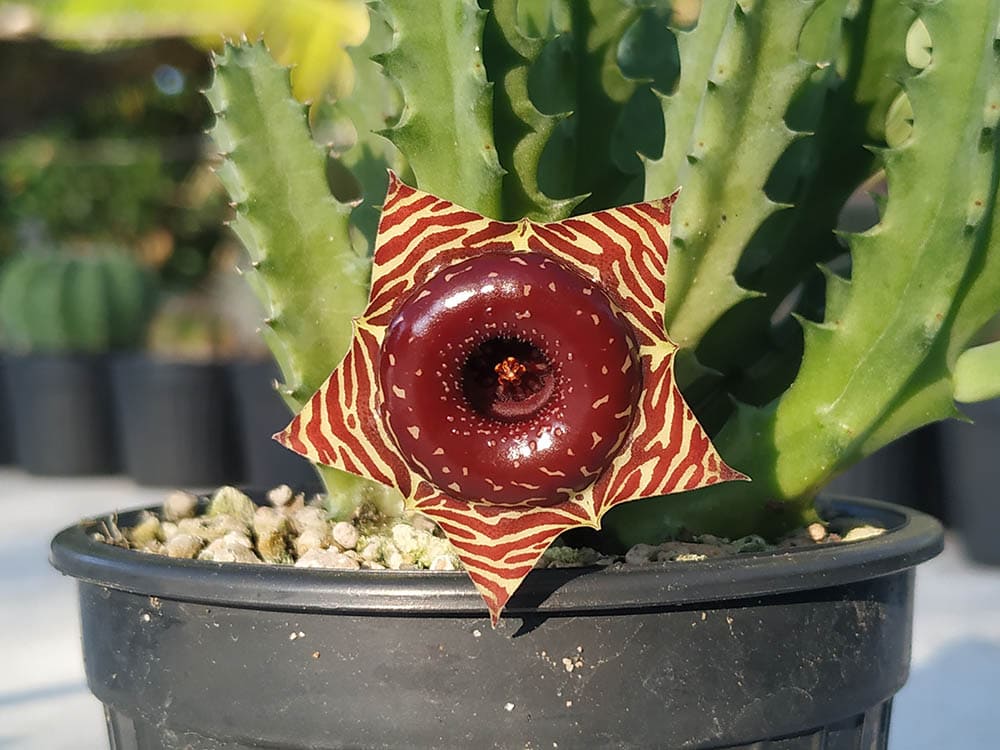
| USDA Hardiness Zone: | 10–11 |
| Flowers: | Yellow and burgundy |
| Size: | 1” wide, 8” tall |
The Lifesaver Cactus (Huernia zebrina) brings bizarre blooms into the home. Flowers consist of a 5-pointed star shape with a shiny, deep burgundy donut in the middle, hence the name. Give them well-drained soil with a healthy mix of bright light and partial shade, and these short cactus stalks will flower from early spring through the summer.
17. Peanut Cactus

| USDA Hardiness Zone: | 10–11 |
| Flowers: | Red, orange, yellow, or purple |
| Size: | 1” wide, 5” tall |
Echinopsis chamaecereus, the “peanut cactus”, is a low-maintenance, warm weather-loving plant consisting of collections of cucumber-like cacti offsets. Robust flowers arrive in the spring. Depending on the variety, the 3”-wide flowers can bloom in vibrant shades of orange, yellow, red, and violet to beautifully contrast the prickly cactus’s lime-green color.
18. Echeveria “Afterglow”

| USDA Hardiness Zone: | 9–12 |
| Flowers: | Orange and red |
| Size: | 24” wide, 24” tall |
Growing up to 2 feet tall and featuring lavender leaves with neon pink edges, Echeveria “Afterglow” is stunning enough without the flowers. With abundant growth and colors that become more intense under bright sunlight, it makes an excellent addition to a rock garden. Tiny orange and red flowers show up in the summer, usually along a long stem that grows from the rosette.
19. Graptopetalum “Ghost Plant”
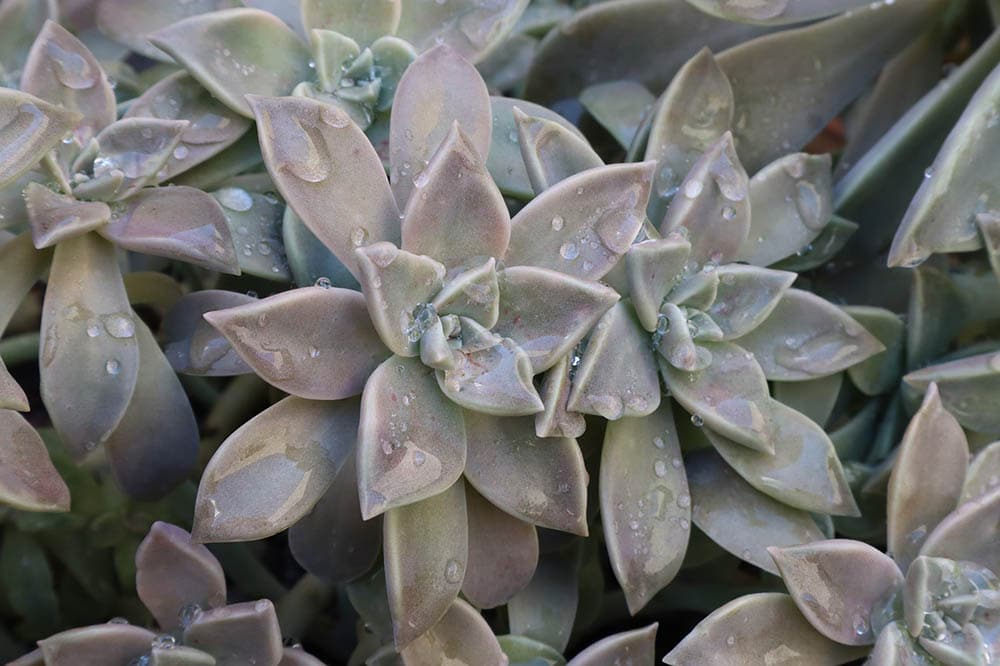
| USDA Hardiness Zone: | 7–11 |
| Flowers: | White and yellow |
| Size: | 24” wide, 12” tall |
Graptopetalum paraguayense “Ghost Plant” grows rosettes of fleshy spearhead leaves on the end of growing stems. Over time, the stems will arch and create a spread up to 3 feet wide.
The blue-gray leaves change to pinkish hues in hot and dry conditions. You can also find variegated plants that incorporate attractive creams, yellows, purples, and pinks in the rosette. In the spring, a stem erupts, growing white, star-shaped flowers with yellow centers and red specks.
20. Hedgehog Cactus

| USDA Hardiness Zone: | 8–11 |
| Flowers: | Orange, red, pink, or purple |
| Size: | Up to 24” tall |
The Echinocereus genus of cacti, the “hedgehog cactus”, is a clumping kind of cacti that can spread up to 3 feet. The spiny, cylindrical growth displays showy flowers from spring to summer. Different types give you red, orange, pink, or violet shades in mesmerizing 3”-wide blooms. Plant them in a rock garden to attract hummingbirds and other wildlife to your backyard.
21. Jelly Bean Plant

| USDA Hardiness Zone: | 9–11 |
| Flowers: | Yellow |
| Size: | 12” wide, 8” tall |
True to its name, the shiny, pebbly leaves of Sedum x rubrotinctum, the “jelly bean plant”, look good enough to eat. The fat green leaves grow up to 1 inch in length, with tips blushing red in extreme hot or cold. Colors change to red on bright summer days, and the glossy coat sparkles in the sunlight. Small, star-shaped yellow blooms arrive as early as late winter, an attractive complement to the lush greens of the leaves.
22. Ruby Necklace

| USDA Hardiness Zone: | 9–11 |
| Flowers: | Yellow |
| Size: | 24” spread |
Othonna capensis, or “ruby necklace”, is a low-growing succulent with long trailing stems covered in bean-shaped leaves. Stems grow a few inches before falling back to the ground and vining out about 1–2 feet. They can be particular with their water and light exposure, but they reward you with fascinating shades of greens, purples, and ruby reds. Yellow daisy-like flowers can grow throughout the year, making a bright accent against the stunning purple and red hues of the stems.
23. Echeveria Peacockii

| USDA Hardiness Zone: | 9–11 |
| Flowers: | Orange and pink |
| Size: | 5” wide, 5” tall |
Echeveria peacockii is a stemless rosette of fleshy, silvery blue leaves. The leaf tips will often have bright red highlights, adding depth and character to an already charming succulent. Rosettes shoot stalks up to 10 inches long in early summer to present long-lasting bell-shaped flowers in hot shades of orange, yellow, and pink.
24. Living Stone

| USDA Hardiness Zone: | 10–11 |
| Flowers: | White, yellow, red, orange, purple, or magenta |
| Size: | 1” wide, 1” tall |
There’s no other succulent like those in the Lithops genus, the “living stones,” consisting of two fat leaves resting in the ground like a stump split down the middle. Available in an array of candy colors, the tops of the leaves often have splotchy tints and shades that add decoration. In the fall, a single flower emerges from between the leaves. It can be a challenge to grow because of its particular watering schedule, but it’s well worth the effort.
25. Christmas Cactus
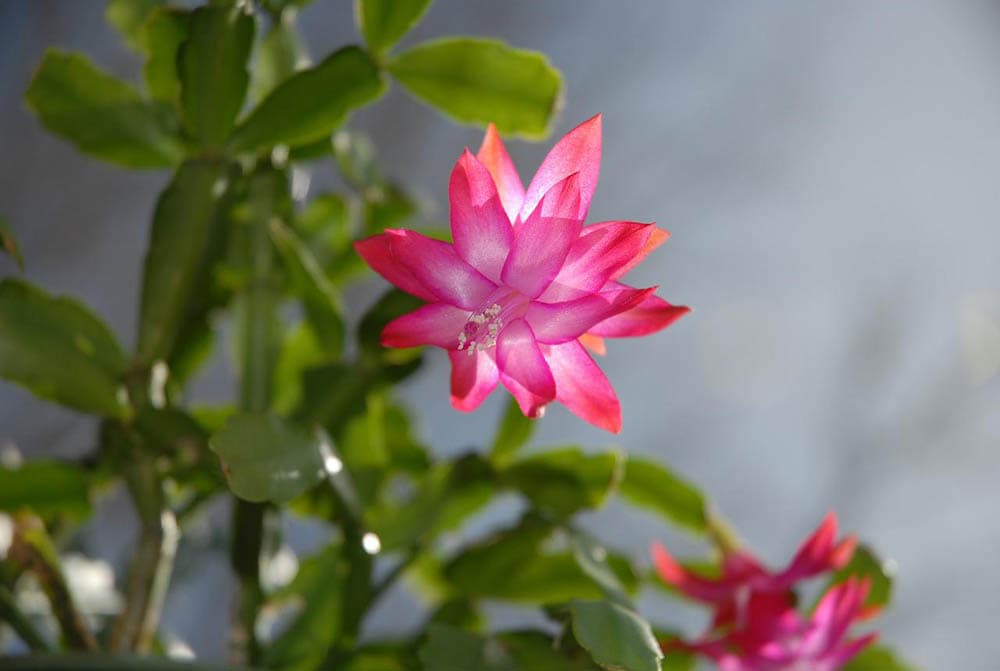
| USDA Hardiness Zone: | 9–11 |
| Flowers: | Red, pink, yellow, orange, white, purple |
| Size: | Up to 24” wide, 6–12” tall |
Blooming around the holidays, the Christmas cactus (Schlumbergera bridgesii) is a popular houseplant prized for its astonishing purplish-red blooms. Also called the crab cactus, it grows long arching stems consisting of several flat segments, resembling the crusty crustacean’s legs. A hefty tubular flower grows at the end of each stem in the winter, presenting dazzling arrays of white, red, and magenta.
26. Red Yucca
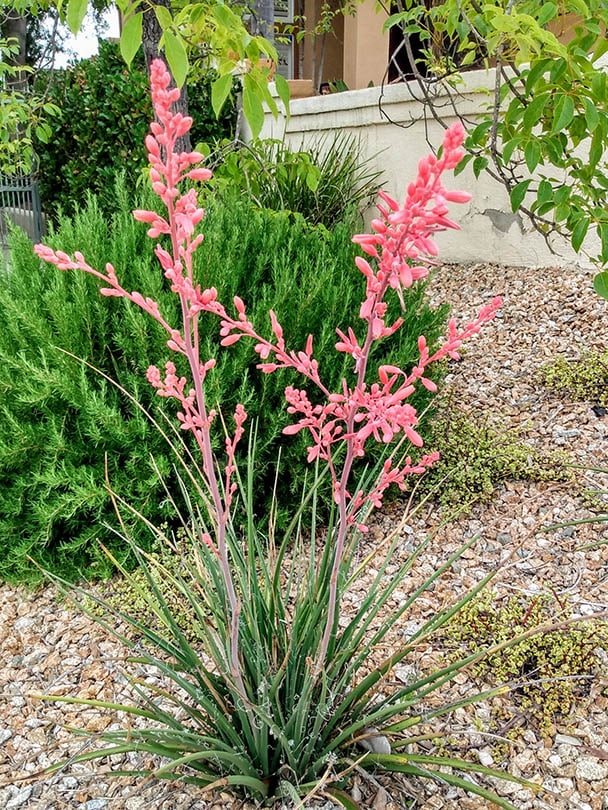
| USDA Hardiness Zone: | 6–11 |
| Flowers: | Red |
| Size: | Up to 6’ spread, 5’ tall |
The blue-green grass-like leaves of the red yucca (Hesperaloe parviflora) are similar to those on a yucca plant, growing up to 3 feet long and arching out into a bushy arrangement. Long stems, growing up to 5 feet, emerge past the leaves, developing red bell-shaped flowers from early spring until summer and possibly the autumn months. The plant is hardier than most succulents and can survive as far north as zone 6, where cold weather turns its leaves a purple-red color.

Final Thoughts
The list of flowering succulents is virtually endless, but some are more valued for their blooms than others. If you want flowers to reappear year after year, look for polycarpic varieties like Echeveria or Anacampseros. But for spectacular results that are sure to delight, get started with any of these 26 exceptional flowering succulents in your garden today.
Featured Image Credit: StillWorksImagery, Pixabay
Contents

